Monthly Tech-Tip from Tony HansenI will send practical posts like these (from thousands I maintain). No ads or tracking. We are troubleshooting the confirm email, for now you will be subscribed immediately (the first monthly email will provide one-click unsubscribe). BlogTurning a cruise into a "Potters Celebration Trip"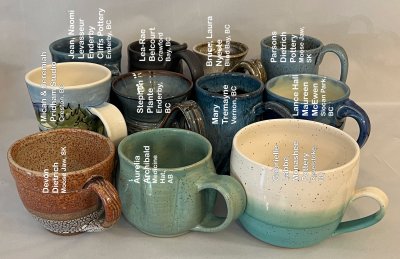
In 2024-25 my wife and I have been on three cruises from Vancouver. Our driving speed of 2-3 days from here (there and back) slows to 4-5 days when we visit potters along the way. The trip this fall was awesome. I cannot believe how resourceful, determined and talented some of our long-time customers are. And I did not stop to think how long some of them have been studio potters (more than 50 or even 60 years). We try to spread our morning coffee out over these and others I have gotten recently (with a preference for those made from Candian clays, of course). It's a real joy to have served you all. We have more trips planned this and next year, so I hope to see many more of you. Context: Celebration Posters Project Friday 24th October 2025 Can engobes be applied to bisque?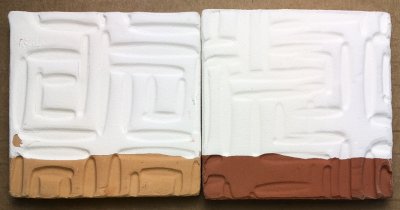
Engobes can be incredibly opaque. This very thin layer of L3685Z2 completely covers these terra cottas (L210 and L215). It's color is whiter than paper! Using my G1916Q and G3879 clear overglazes, ware can appear as white as porcelain! But notice there are tiny cracks in the white on the edges of contours (most noticeable on the left sample). It appears to work well when applied to the bisque (because I added CMC gum), but during firing, it shrinks 2%, putting it under tension (the body had already shrunk during its bisque). If it were applied to the leather-hard ware that would not fix the problem. Why? Because the body shrinks 4%, that would put it under compression, looking for opportunities to flake off at edges (e.g. rims of mugs). How to optimize this? The engobe needs about 3% Ferro Frit 3110 to raise its firing shrinkage by 2%. And, to be applied to leather-hard ware. Context: Match the firing shrinkage.. Monday 13th October 2025 Transparent over-glaze for cone 6 stonewareIs a good one even possible on brush decorated ware?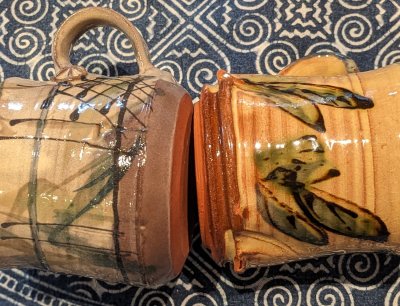
The mug on the right is terra cotta slipware fired at cone 04 using underglazes and a leaded transparent over-glaze (lead glazes are still commonly used in many parts of the world and considered safe there). Mug on the left: This potter wants to use the same technique on cone 6 stoneware. This is a typical transparent glaze (fluxed using a frit or Gerstley Borate). The result is micro-bubble clouding, boron blue, washed-out colors and surface defects. Because it is a dipping glaze it went on too thick and didn't cover well over the colored brushstrokes. However, achieving better warm browns is possible. A more refractory underglaze (made with stains, not iron oxide) that does not bleed. A more fluid melt transparent glaze that is better able to shed bubbles. A drop-and-hold firing would reduce surface defects. Finally, careful control of the glaze thickness and quality of laydown. To achieve the latter, it might be worth preparing the transparent as a brushing glaze, at least for application on the outsides (enabling a dense and even laydown over the whole surface). Context: Why dipping transparent glazes.., Underglazes require a fluid.., The right transparent glaze.., Engobe, Underglaze Tuesday 23rd September 2025 Stains are better in black glazes5% stain vs 15% metal oxides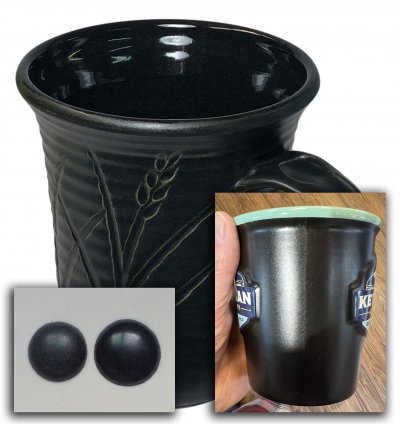
Consider the hazards and hassles before choosing a black matte or gloss recipe that has high individual or combined percentages of manganese dioxide, cobalt or nickel. Context: Ceramic Stain Toxicity Label.., Control matteness by glaze.., Heres evidence that using.., Ceramic Stain, Toxicity Thursday 18th September 2025 Thickly applied slips must fit the body and each other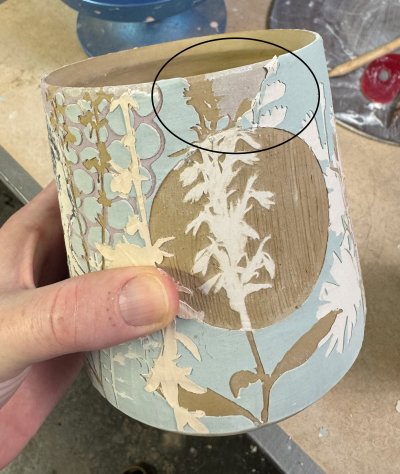
Fit? It has to stick well. And stay stuck during drying (and shrinking). And the bond has to survive shrinkage that happens during firing. This potter is doing thick applications of each slip (actually that makes them engobes). She uses stains, that's wise, metal oxides bring baggage when used to color slips (e.g. their decomposition can affect the bond, they can gel the slurry, flux the fired product thereby increasing the firing shrinkage of the slip). Stains are better because they affect slurry and fired properties less. But there are still enough issues that each colored slip deserves testing. This potter first slaked B-mix as a slip (it is highly plastic), using it at a runny yogurt consistency. But it bubbled when fired hotter than a cool cone 6. A switch to porcelain slip (which is non-plastic) is shown here. It flaked off as it dried (even in a damp box for 24 hours), also after bisquing to cone 08, and sometimes even after firing to cone 6. This signalled a drying mismatch between body and slip, the bond that managed to survive drying was weakened enough to fail on firing. Context: L3954B, This pottery glaze is.. Monday 15th September 2025 A giant cookie-cutter for slab built mugsView and print it now using the Downloads page linkAvailable on the Downloads page 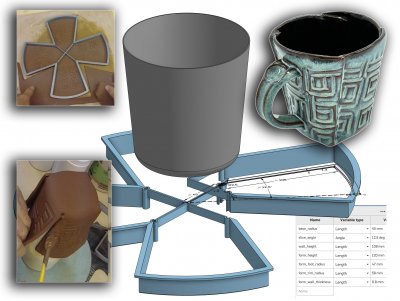
3D print four of these and glue them together to make a large cookie cutter for producing slab-built mugs. 3D print the cup, fill it with plaster and remove the PLA using a heat gun. Roll out a thin slab of clay, press the cutter into it using a round wooden batt, make sure it is not sticking to the board and flip it over onto the plaster form. Handles can even be attached while it is on the form. If clay is plastic it can be used quite stiff. Experiment, adjust sizing and dimensions and reprint to fine-tune. Context: Large cookie-cutter 3D-printed in.., 3D Design, Pie-Crust Mug-Making Method, Cookie Cutting clay with.. Monday 15th September 2025 Recognize these universal oxidation glazes?Almost every potter needs a Albany brown and rutile blue.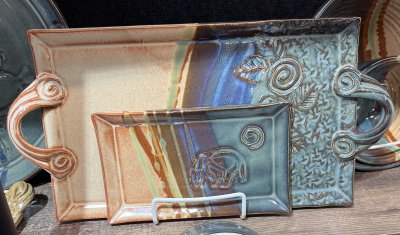
These are made by Barbara Childs Pottery (I saw them on sale in a tourist shop in Alaska). To keep costs down, I first assumed they use dipping glazes they mix themselves. Potter's Choice PC-32 Albany Slip Brown and PC-20 Rutile Blue hobby glazes emulate these long time pottery glaze recipes. However, a reader noted that Barabara Childs uses Clay Art Center’s Stellar Rust and Floating Blue (with guest appearances by Blue Green). But Amaco and Clay Art don't just use the traditional recipes; they adapt and improve them. Consider the rutile blue. Neither is using the traditional G2826R floating blue recipe, there are new and better ways using recipes like GA6-C and GR6-M. Likewise, with the brown, they are not using the traditional G2415E Albany Brown recipe. Rather, they improve it (e.g. like we did with G3933G1). High on their list of improvements would have been a way to reduce or remove the lithium to cut costs. Maybe you are a hobbyist and don’t feel you need to DIY your costs down. But do your customers feel the same way? Not buying just ten small jars of hobby brushing glaze will pay for a mixer and much of the ingredients to make gallons of each of these as dipping glazes. It will also set you on the road to gradually improving the glazes you use. And even reducing your prices. What about buying premixed powders? Yes, that is much less expensive. But if you are mixing the glaze from one manufacturer with the clay body from another, crazing is an ever-present issue. Mixing your own enables an adjustment to fix the problem. Context: Adding 6 lithium carbonate.., PC-2 floating blue with.. Tuesday 9th September 2025 A draining issue with a slip cast bottleIt is turning inside out!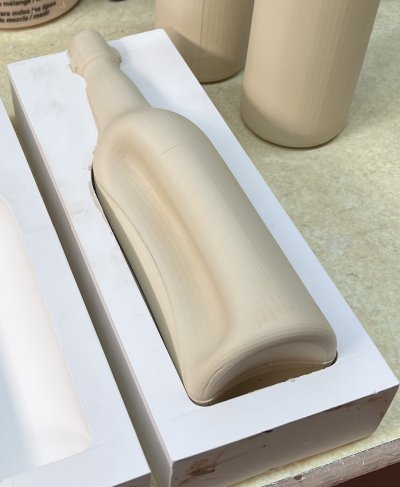
Why did this happen? There is a perfect storm of factors. Draining, during slip casting, creates suction and slip is heavy (1.8 times heavier than water). And this mold is tall with a narrow neck. So that creates a lot of suction. A slip having inadequate fluidity complicates draining. This round shape, even with printing artifacts, also releases well. How can this issue be avoided? Context: Slip Casting, Beer Bottle Master Mold.., Casting Slip Problems Saturday 6th September 2025 OnShape CAD is Free for Hobby Makers:Is it as good as Fusion 360?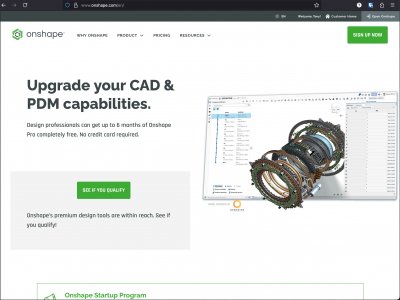
It is very hard to let Fusion 360 CAD go. But the approaching $750 renewal is powerful motivation! OnShape is amazing. There is nothing to install, it runs in a browser tab like Google docs (see picture below). Sure, it won’t run offline, but I am almost never offline. It functions very similar to Fusion 360 for my basic requirements of making molds for slip casting. Recent experience with the complexity and slowness of Solidworks for Makers, which is total overkill for what I need, really makes OnShape look good. Context: 3D mechanical design software.., 3D Printed Pour-spout Forms.., My Breakup with Fusion.., OnShape parametric cloud-native CAD.. Saturday 6th September 2025 Classic Medalta Potteries Beer BottleMake this mold using OnShape and Fusion 360
The original bottles were hand-thrown and very thick and heavy. These are perfect candidates for slip casting. Context: Drawing the Same Mold.., Slip cast a stoneware.., Beer Bottle Master Mold.. Saturday 6th September 2025 | Contact MeUse the contact form at the bottom on almost all the pages on this site or let's have a Other ways to Support My WorkSubscribe to Insight-Live.com. It is about doing testing and development, not letting the information slip away. Starts at $15 for 6 months. Help Me on Social
Login to your online account Chemistry plus physics. Maintain your recipes, test results, firing schedules, pictures, materials, projects, etc. Access your data from any connected device. Import desktop Insight data (and of other products). Group accounts for industry and education. Private accounts for potters. Get started. Download for Mac, PC, Linux Interactive glaze chemistry for the desktop. Free (no longer in development but still maintained, M1 Mac version now available). Download here or in the Files panel within your Insight-live.com account. What people have said about Digitalfire
What people have said about Insight-Live
|

https://digitalfire.com, All Rights Reserved
Privacy Policy








